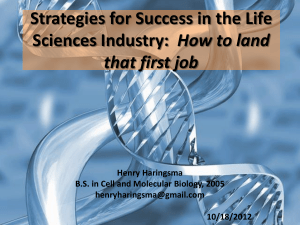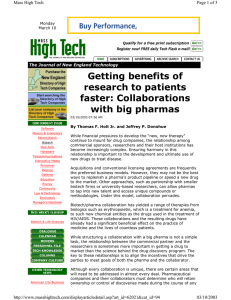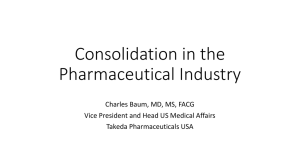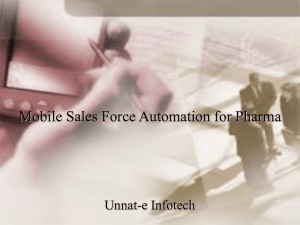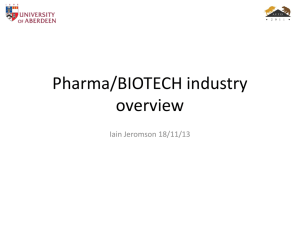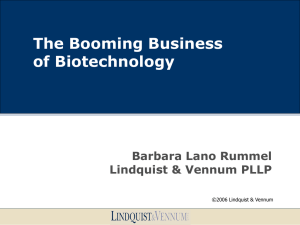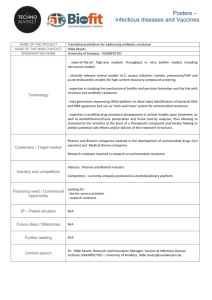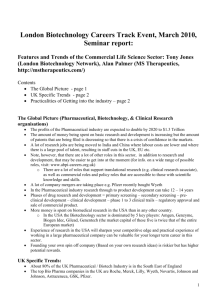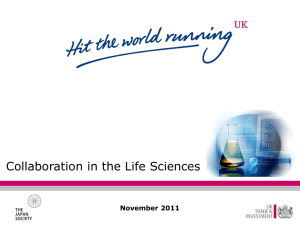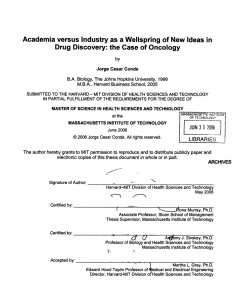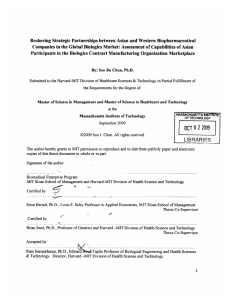Oxford Bioscience Partners Presentation
advertisement
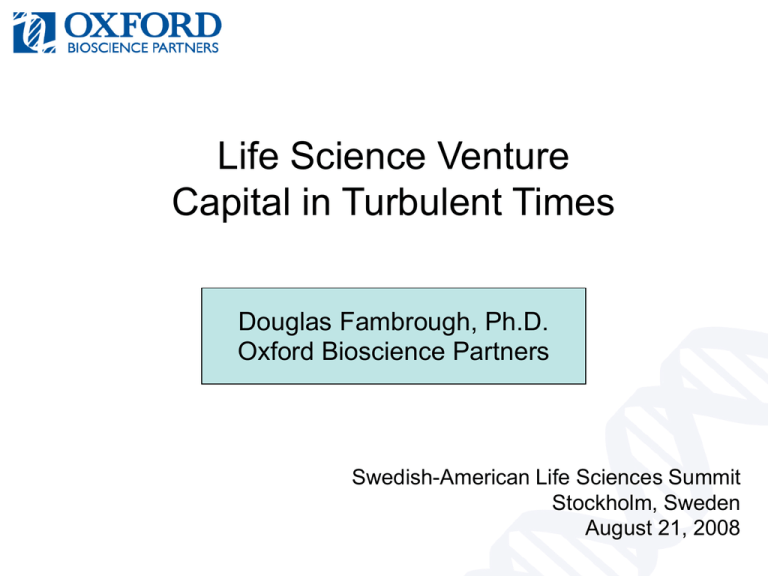
Life Science Venture Capital in Turbulent Times Douglas Fambrough, Ph.D. Oxford Bioscience Partners Swedish-American Life Sciences Summit Stockholm, Sweden August 21, 2008 Oxford Bioscience Partners • Leader and innovator in life science VC • Five funds totaling $1B of committed capital • Based in Boston, MA • Proven investment performance • Team of 5 general partners and 5 additional investment professionals • Investing in biopharma, medical devices, life science research tools, and select life science opportunities outside of healthcare • Particular strength in innovative life science technologies such as genomics, RNAi, bioenergy, etc. Biotech has come of age after 2000 • Pharma is increasingly dependent on these drugs • A spate marketed biologic acquisitions: – 2007: AZ - MedImmune – 2008: Roche - Genentech – 2008: BMS - ImClone • Biotech is fundamental the pharmaceutical industry $ billion • Biologics are some of the industry’s biggest sellers 2007 WW Revenue of selected biologics approved in the last decade Big Pharma is turning into Big BioPharma Pfizer is committed to establishing itself as a leader in biotherapeutics… Pfizer Annual Report 2007 …Wyeth [is] the world’s fourth largest biotechnology company by revenue Wyeth Annual Report 2007 We were one of the first pharmaceutical companies to get involved in biotechnology in the 1980s through our relationship with Genentech. Biopharmaceuticals now account for 55% of our revenue Roche Annual Report 2007 The consolidation of all our biologics capabilities from AstraZeneca, Cambridge Antibody Technology (CAT) and MedImmune into one unit immediately creates one of the world’s largest biologics pipelines and establishes us as a leader in biotechnology among our pharmaceutical peers.” AstraZeneca Annual Report 2007 % Of Revenue At Risk from Patent Expirations 2007-2011 Tremendous pressure on Pharma cash flows Despite the centrality of biotechnology to the pharmaceutical industry, the broader biotech community is struggling Global Environment • Credit crunch and recession crimping markets • Pharma somewhat sheltered, but biotechs caught in market retreat • VC also affected, fundraising down 30% • Rising health care costs suggest future pressures on industry • Regulators running scared Healthcare spending expected to reach $4.3 Trillion by 2016! Healthcare spending was $2.3 trillion in 2007 Global Environment – It’s Not All Bad • Potential revenue growth in developing markets • Growing need for biotech outside of healthcare • Biologic technologies continue to mature • Genomics moving out of basic research and toward medical practice Healthcare spending expected to reach $4.3 Trillion by 2016! Healthcare spending was $2.3 trillion in 2007 A Transition in the BioPharma Venture Capital Process Focus on the exit environment The “good old days”: VC in the 1990s After the bubble: VC in the 2000s • Most IPOs carried a nice premium • IPOs are rarer, require more maturity, and are poorly priced • Many non-specialist investors (including retail) providing higher prices and liquidity • The rise of the buyside biotech specialist; not an active trader, risk sensitive • Sell-side analysts well compensated and effective • Spitzer settlement (2002) has led to a big decline in sell-side analysis How bad is it out there? “We threw an IPO and nobody came” Wall Street Journal 2002 Number of Nasdaq Biotech IPOs 2001-2008 Birth of the $7 special A modest number of IPOs mid-decade, now back in the deep-freeze Capital Raised Prior to IPO vs IPO Pre-Money $mn Premiums Have Declined Since 2001 Number of Stocks Post-IPO Performance: Current Price vs Offering Price Few stocks have shown sustained value creation Is the IPO Decline Temporary and Permanent? Decline of retail interest in the sector Trading volumes are meager Could change Rise of biopharma specialist investors Biotech Value Fund, MPM Bioequities, etc. Permanent Acquisition and dismantling of specialist sell-side investment banks Alex Brown, H&Q, Robertson Stephens Permanent Tightened regulatory environment has increased risk More clinical ‘implosions’ Could change So what is a VC to do? An Existentialist Market? Or Shakespeare? “No Exit” “As You Like It” “The Myth of Sisyphus” “Much Ado About Nothing” “Waiting for Godot” “All’s Well That Ends Well” High Value M&A Deals Becoming A Favored Route For Exit M&A deal rate seems fairly stable through current market crisis Capital Raised Prior to M&A vs M&A Value Pharma Innovation Trends Suggest M&A Will Continue “Closed Loop” Innovation Area Late Stage Licensing and Mega Merger Area % Sales From Internally Discovered Drugs Top 10 Pharmaceutical Companies in 2006 Source: Defined Health “Open Loop” Innovation Area Big Pharma Internalizing Biotech Pfizer is organizing their new Biotherapeutics and Bioinnovation Center around biotech acquisitions: BBC is run out of Rinat in SSF CovX operates as a separate facility in SD Coley talent running Cambridge RTC facility “We will preserve the unique cultures of these biotherapeutic organizations … [and] get out of their way.” -- Corey Goodman GSK CEDDs Structure: Sirtris acquisition feeds a growing Cambridge-based metabolic group “The CEDDS create the spirit of a small R&D-led team within a very large pharmaceutical organization and allow us to be more nimble, and therefore more productive, in our approach.” GSK Annual Report 2007 Planning an M&A is hard to do What’s A Venture Capitalist To Do? • Fund Companies Attractive to Acquirers – – – – – Large market focus Biologics > Small Molecules “Big Pharma” programs, not “Wall Street” programs Compelling mechanism of action: HSP90, DPP4, b-catenin Proprietary Innovation • North America and Europe remain the center of pharma innovation • Capital Efficiency – Exit values rarely >$500 million; less investment means more ROI – Outsourcing to save costs: China, India • Biologics Platform Companies – Propriety technology with unique/scarce capability – Compelling commercial opportunity enables by the technology – Compelling team that will transfer the technology • Moving Genomics from Basic Research to Medical Science Sirna Therapeutics Case Study Sirna Illustrated the ‘three-legged stool’ model for successful platform investing Launched in spring ’03 First partnership late ‘05 Acquired for $1.1 billion in late ‘06 Proprietary biologics platform – RNA Interference RNAi opens up new targets to drug development Commercially compelling programs – HCV, diabetes Unpartnered programs were pre-clinical Strong team to transfer technology Background in antisense, ribozymes and translational medicine The Plummeting Cost of Genetic Info Creates new business opportunities Mol diagnostics, risk assessment, non-healthcare applications Requires a new generation of tools Sequencing, gene expression, instruments for non-specialists The cost of one base of DNA, in dollars, by year 100 As costs continue to decline, genomic information will become increasingly important to medical practice. Eventually everyone will have their genome sequenced. 10 1 0.1 0.01 0.001 0.0001 1E-05 1E-06 1985 1990 1995 2000 2005 Genomic Medical Record 2010 2015 Where is Genomics Going? The $1000 Genome (or less!) Third-gen sequencers Treating the Genome Drugs that directly edit the genomic program to cure diseased cells The Genomic Medical Record The most fundamental information Genomic Engineering and Meta-Genomics • Designer microbes • Environmental applications Challenging Areas for VCs Whenever a small company bears the risk of late-stage clinical success, the numbers will be against them Taking clinical programs through phase III data exposes VC investors to the full integrated risk of drug development Challenging Areas for VCs • Whenever a small company bears the risk of late-stage clinical success, the numbers will be against them – Risk-share deals that generate a strong IPO story often set a company up for a devastating clinical failure – Later stage clinical development forces a company is ever larger and more dilutive rounds of financing • In-licensing, re-purposing, NRDO models, etc. – Seldom are these programs sought for acquisition, – The clinical track record is poor relative the promise of “de-risked programs” that this model assumes • Pharma-specific research tools, software, etc – Pharma wants these tools but won’t pay for them Life Science Venture Capital in Turbulent Times Douglas Fambrough, Ph.D. Oxford Bioscience Partners Swedish-American Life Sciences Summit Stockholm, Sweden August 21, 2008

